Albert III (German: Albrecht III.) (9 November 1414 – 11 March 1486), often known simply as Albert Achilles (Albrecht Achilles), was a Prince-elector of the Margraviate of Brandenburg. He received the nickname Achilles because of his knightly qualities. He also ruled the Principality of Ansbach.
Albert was born in Tangermünde as the third son of Elector Frederick I and his wife, Elisabeth of Bavaria-Landshut. After passing some time at the court of Emperor Sigismund, Albert took part in the war against the Hussites, and afterwards distinguished himself whilst assisting the German king, Albert II, against Poland.[1]
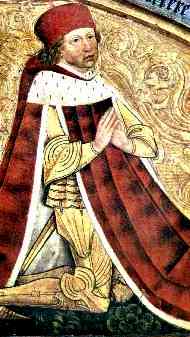
Anna of Saxony (7 March 1437 – 31 October 1512) was a princess of Saxony by birth and Electress of Brandenburg by marriage.
Anna was a daughter of the Elector Frederick II of Saxony from his marriage to Margaret of Austria, daughter of the Duke Ernest of Austria.

William (German: Wilhelm) called William the Younger (German: Wilhelm der Jüngere, c. 1425 – 7 July 1503) was duke ofBrunswick-Lüneburg and ruled over the Wolfenbüttel and Göttingen principalities.
The eldest son of William the Victorious, Duke of Brunswick-Lüneburg, he was given the Principality of Göttingen by his father in 1473. In 1482 the father died, and he and his brother Frederick succeeded their father in the remaining parts of his state; however, William had Frederick imprisoned in 1484 and made himself sole ruler. In 1490 he bought the City of Helmstedt from the Abbott ofWerden. In 1491, William gave the Principality of Wolfenbüttel including Calenberg to his sons, and kept only Göttingen to himself. In 1495 he resigned as prince of Göttingen in favour of his son Eric I in return for an appanage. William died on 7 July 1503 inHardegsen.
Edzard I, also Edzard the Great, (Greetsiel, 15 January 1462 – Emden, 14 February 1528) was count of East Frisia from 1491 till his death in 1528.
Edzard succeeded his brother Enno in 1492. He fought with George, Duke of Saxony over Friesland and Groningen. The city ofGroningen accepted him as its lord in 1506, but in 1514 renounced him again in favor of Charles of Guelders.
After he returned from a pilgrimage to Jerusalem in 1492, he took over the rule of East Frisia together with his mother Theda. After his mother died in 1494, he ruled together with his less significant brother Uko. Ulrich I y
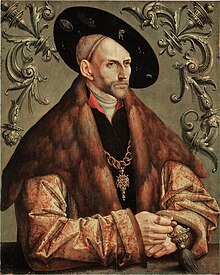
Elisabeth of Rietberg-Arnsberg (1470 - 1512), daughter of John I, Count of Rietberg
John V, Count of Oldenburg and Delmenhorst (also counted as John XIV, including also non-ruling namesake siblings; 1460,Oldenburg – 10 February 1526, Oldenburg) was a member of the House of Oldenburg. He was the ruling Count of Oldenburg from 1500 to 1526. His parents were Gerhard VI, Count of Oldenburg and Adelheid of Tecklenburg.

Magnus I of Saxe-Lauenburg (Ratzeburg, 1 January 1488 – 1 August 1543, Ratzeburg) was a Duke of Saxe-Lauenburg from theHouse of Ascania.
Magnus was the second son of John V, Duke of Saxe-Lauenburg and Dorothea of Brandenburg, daughter of Frederick II, Elector of Brandenburg.
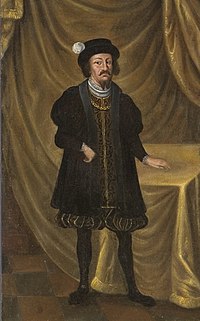
Catherine of Brunswick-Wolfenbüttel (1488 – 29 June 1563, Neuhaus upon Elbe) was a member of the house of Welf and a Princess of Brunswick-Wolfenbüttel and by marriage Duchess of Saxe-Lauenburg.
Catherine was a daughter of the Duke Henry IV of Brunswick-Lüneburg (1463–1514) from his marriage to Catherine of Pomerania(1465–1526), daughter of the Duke Erich II of Pomerania.
Gerhard VI "the Quarrelsome", Count of Oldenburg (German: Gerhard (Gerd) der Mutige von Oldenburg; 1430 – 22 February 1500) was a Count of Oldenburg and regent of Bad Zwischenahn in 1440–1482.
Gerhard was the third son of Dietrich of Oldenburg and his wife, Helvig of Schauenburg. His eldest brother succeeded their father as Christian VI but was elected King Christian I of Denmark in 1448, therefore passing on the county to his brothers in 1450. In 1440–1463 Gerhard VI ruled in Delmenhorst as regent and in 1464–1482 (after the death of his brother Maurice) as the guardian of his nephew Jakob. He was constantly at war with Gerhard III, Prince-Archbishop of Bremen, and Frisians. In 1483 Gerhard was compelled to abdicate in favor of his sons, and he died whilst on a pilgrimage in the Rhône river valley.
John IV, Duke of Mecklenburg (before 1370 – 16 October 1422) was sole ruler of the Duchy of Mecklenburg from 1384 to 1395 and co-regent from 1395 to 1422.
John IV was the only son of the Duke Magnus I of Mecklenburg and his wife Elisabeth of Pommern-Wolgast. Ernst Boll incorrectly refers to him as "John III" in his History of Mecklenburg, Part 1.
Catherine of Saxe-Lauenburg (born: circa 1400; died: 22 September 1450), was Duchess of Saxe-Lauenburg by birth and by marriage Baroness of Werle-Güstrow and later Duchess of Mecklenburg and Regent from 1422 to 1436. All of these places are located in what is now called northern Germany.
Catherine was the daughter of Eric IV and Sophia of Brunswick-Lüneburg. She married firstly, John VII of Werle. He died in 1414. She then married the Duke John IV of Mecklenburg in 1416. When John died in 1422, after six years of marriage, she ruled until 1436 as Regent for her minor sons.
Frederick (German: Friedrich; 21 September 1371 in Nuremberg – 20 September 1440) was Burgrave of Nuremberg as Frederick VI and Elector of Brandenburg as Frederick I. He was a son of Burgrave Frederick V of Nuremberg and Elisabeth of Meissen, and was the first member of the House of Hohenzollern to rule the Margraviate of Brandenburg.

Elisabeth of Bavaria-Landshut (1383 – 13 November 1442), nicknamed "Beautiful Beth", was an Electress of Brandenburg.
Elizabeth was a daughter of Duke Frederick "the Wise" of Bavaria-Landshut and his second wife Maddalena Visconti. On 18 September 1401 she married Frederick VI of Hohenzollern, Burgrave of Nuremberg, who was promoted to Elector of Brandenburg in 1415 and ruled as "Elector Frederick I". During her husband's long journeys to Italy, Hungary, and to the Council of Constance, she represented him wisely despite the great political problems Brandenburg was experiencing at the time.
She is the ancestress of the royal line of the House of Hohenzollern by her third son Albert III Achilles, Elector of Brandenburg.

Duke Wartislaw IX of Pomerania-Wolgast (c. 1400 – 17 April 1457, Wolgast) was the eldest son of the Duke Barnim VI, Duke of Pomerania and Veronica. Europaische Stammtafaln does not cite an origin for Veronica.[1]
He reigned from 1417 until his death in 1457 and he married to Sophia of Saxe-Lauenburg-Ratzeburg in 1420. They had 4 children:Eric II, Wartislav X, Elizabeth and Christopher (who died young).

Bogusław IX; (1407/1410 – 7 December 1446) was a duke of Pomerania in Pomerania-Stolp, whose residence was Stargard. His cousin Eric of Pomerania tried in vain to have him recognized as King of the Kalmar Union.
Bogusław was the son of Bogislaw VIII, Duke of Pomerania, and Sophia of Holstein. On June 24, 1432 in Poznan he married Maria of Masovia, daughter of Siemowit IV, Duke of Masovia and Alexandra of Lithuania.[1] They had daughters, Sophia, who married Eric II, Duke of Pomerania, and Alexandra, and at least one of unknown name.[2]
During the Polish–Teutonic War (1431–1435), Bogislaw opposed the Teutonic Knights and supported the Kingdom of Poland. He was later involved in struggles related to Pomeranian bishops.
Bogusław was succeeded by Eric of Pomerania.
Maria of Masovia (pl: Maria mazowiecka; 1408/15 - 14 February 1454), was a Polish princess member of the House of Piast in the Masovian branch.
She was the sixth daughter of Siemowit IV, Duke of Masovia and Alexandra, a daughter of Algirdas, Grand Duke of Lithuania and sister of King Władysław II Jagiełło of Poland.
Cristián I nació en febrero de 1426 en Oldemburgo, (Alemania), hijo del conde Teodorico de Oldemburgo y de Hedvig de Holstein. Cuando su padre falleció en 1440, Cristián heredó el título de conde de Oldemburgo y Delmenhorst. Por ese mismo tiempo fue nombrado por su tío Adolfo VIII de Holstein como su sucesor para ocupar el condado de Holstein.
Dorotea de Brandeburgo (1430/1431 - Kalundborg, 10 de noviembre de 1495). Reina consorte de la Unión de Kalmar, esposa del rey Cristóbal de Baviera y después de la muerte de éste, de Cristián I. Duquesa de Oldemburgo y de Schleswig-Holstein.
Dorotea era hija del margrave Juan de Brandeburgo-Kulmach y de la duquesa Bárbara de Anhalt. Tuvo dos hermanas: Bárbara de Brandeburgo (1423-1481), quien sería duquesa de Milán, e Isabel (fallecida en 1451), quien sería duquesa de Pomerania.

Ernesto (Meissen, 25 de marzo de 1441 - Colditz, 26 de agosto de 1486) fue un noble alemán, príncipe-Elector de Sajonia (1464-1486), duque de Sajonia-Wittenberg (1464-1486), Landgrave de Turingia (1464-1485) y Margrave de la marca de Meissen (1464-1485).
Era hijo de Federico II de Sajonia el Apacible y Margarita de Austria.
Isabel de Baviera-Múnich (2 de febrero de 1443, Múnich - 5 de marzo de 1484, Leipzig) fue princesa de Baviera-Múnich por nacimiento y por matrimonio fue Electriz de Sajonia.
Isabel era hija del duque Alberto III el Piadoso de Baviera-Múnich (1401-1460) de su matrimonio con Ana de Brunswick-Grubenhagen-Einbeck (1420-1474), hija del duque Eric I de Brunswick-Grubenhagen.
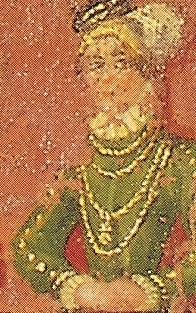
Derrick or Dietrich of Oldenburg, Latin-based Anglicisation also Theoderic of Oldenburg [1] (c. 1398 – 14 February 1440), nicknamed Theoderic the Lucky or the Fortunate (Teudericus Fortunatus), was a feudal lord in Northern Germany, holding the counties of Delmenhorst and Oldenburg. He was called "Fortunatus" as he was able to secure Delmenhorst for his branch of the Oldenburgs.
Dietrich was the father of Christian I of Denmark, a male-line ancestor to the present-day Danish throne under Margarethe II of Denmark as well as the last Czar of imperial Russia, Nicolas II. He is also the male line ancestor of Charles, Prince of Wales andHarald V of Norway.
Dietrich of Oldenburg was the son of Christian V of Oldenburg (who became count in about 1398 and died in 1423) and his wife, Countess Agnes of Honstein (c. 1410–1460). His grandfather, Conrad I of Oldenburg (d. ca. 1368) had left his lands divided between Dietrich's father and uncle, Conrad II.

Helvig of Schauenburg (German: Heilwig von Holstein) (1398–1436), also known as Hedwig of Schauenburg,[citation needed] was a duchess of Schleswig and a countess of Holstein from the family of Schauenburg, and ancestor of the Danish Royal houses ofOldenburg and Schleswig-Holstein-Sonderburg-Glücksburg.
She was a daughter of Gerhard VI of Holstein-Rendsburg and his wife, Catherine Elisabeth of Brunswick-Lüneburg. Her brother wasAdolf VIII/I, Count of Holstein/Duke of Schleswig. Through their father, they were cognatic descendants of King Eric V of Denmarkwhile through their mother, they were cognatic descendants of King Abel of Denmark.

Bernard II of Saxe-Lauenburg (German: Bernhard II.; ca. 1385/1392–16 July 1463) was a member of the House of Ascania and Duke of Saxe-Lauenburg from 1426 to 1463. His full title was Duke of Saxony, Angria and Westphalia, however only ruling the branch duchy of Saxe-Lauenburg between 1426 and 1463.
He was a son of Eric IV, Duke of Saxe-Lauenburg and Sophia of Brunswick-Lüneburg. Since long Bernard urged his ruling brotherEric V to share his reign. Failed in his fight for the Saxon electorate Eric finally agreed and made Bernard the co-duke of Saxe-Lauenburg in 1426.[1] When Eric V died in 1435 Bernard continued the reign alone.
Frederick II of Brandenburg (German: Friedrich II.) (19 November 1413 – 10 February 1471), nicknamed "the Iron" (der Eiserne) and sometimes "Irontooth" (Eisenzahn), was a Prince-elector of the Margraviate of Brandenburg from 1440 until his abdication in 1470, and was a member of the House of Hohenzollern. Frederick II was born in Tangermünde to Frederick I, Brandenburg's first Hohenzollern ruler, and his wife Elizabeth, daughter of Frederick, Duke of Bavaria-Landshut, and Maddalena Visconti. The latter was a daughter of Bernabò Visconti and Beatrice della Scala. As the second son, his brothers included John the Alchemist and Albert Achilles, both of whom also ruled Brandenburg as margraves.ç

Catherine of Saxony (1421 – 23 August 1476) was a princess of Saxony by birth and Electress of Brandenburg by marriage.
Catherine was a daughter of the Elector Frederick I of Saxony (1370–1428) from his marriage to Catherine of Brunswick-Lüneburg(1395–1442), daughter of Duke Henry I, Duke of Brunswick-Lüneburg.
William (German: Wilhelm) called William the Younger (German: Wilhelm der Jüngere, c. 1425 – 7 July 1503) was duke ofBrunswick-Lüneburg and ruled over the Wolfenbüttel and Göttingen principalities.
The eldest son of William the Victorious, Duke of Brunswick-Lüneburg, he was given the Principality of Göttingen by his father in 1473. In 1482 the father died, and he and his brother Frederick succeeded their father in the remaining parts of his state; however, William had Frederick imprisoned in 1484 and made himself sole ruler. In 1490 he bought the City of Helmstedt from the Abbott ofWerden. In 1491, William gave the Principality of Wolfenbüttel including Calenberg to his sons, and kept only Göttingen to himself. In 1495 he resigned as prince of Göttingen in favour of his son Eric I in return for an appanage. William died on 7 July 1503 inHardegsen.
Eric II or Erich II (between 1418 and 1425 – 5 July 1474) was a member of the House of Pomerania (also known as the House of Griffins) and was the ruling Duke of Duke of Pomerania-Wolgast from 1457 to 1474. He was the son of Wartislaw IX of Pomerania-Wolgast and Sophia, daughter of Eric IV of Saxe-Lauenburg.

Sophia of Pomerania-Stolp (1435 – 24 August 1497), was a Duchess of Pomerania by birth, and married to Eric II, Duke of Pomerania.
Sophia was the daughter of Bogislaw IX, Duke of Pomerania and Maria of Masovia. In 1446, her father died and was succeeded by his cousin, Eric of Pomerania, former King of Denmark, Norway and Sweden. Sophia became the heir of Eric of Pomerania's private fortune. In 1451, Sophia was married to Eric of Pomerania-Wolgast, making her spouse the heir of Eric of Pomerania's territories, while Sophia remained the heir of Eric of Pomerania's private fortune. At the death of Eric of Pomerania in 1459, Sophia's husband united Pomerania through the inheritance of Pomerania-Stolp and Pomerania-Rügenwalde by his marriage, while Sophia became the sole possessor of the vast fortune brought by Eric of Pomerania from his former kingdoms's in Scandinavia, as well as the one he had acquired by his piracy activity on Gotland.
Luis VI del Palatinado (Simmern 4 de julio de 1539 - Heidelberg, 22 de octubre de 1583) fue un príncipe elector del Palatinado-Simmern, rama de la casa de Wittelsbach. Era el hijo primogénito de Federico III del Palatinado y María de Brandeburgo-Kulmbach.

He was the son of Count Wolrad I and his wife Barbara of Wertheim. He inherited the County of Waldeck when his father died in 1475, and died himself later that year. Nothing remarkable happened during his brief reign.
Johanna of Nassau-Dillenburg (c. 1444 – c. 1468) was a daughter of Count John IV of Nassau and his wife Maria of Loon-Heinsberg.
Augusto (en alemán: August; Freiberg, 31 de julio de 1526 - Dresde, 11 de febrero de 1586) fue un príncipe elector de Sajonia de la Casa de Wettin.
Augusto era el menor de los hijos de Enrique V de Sajonia-Meissen y Catalina de Mecklemburgo. Educado como luterano, recibió una excelente instrucción e incluso pudo estudiar unos años en la Universidad de Leipzig.
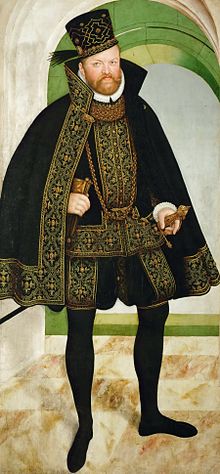
Juan Jorge I de Hohenzollern (en alemán: Johann Georg); 11 de septiembre de 1525 – 8 de enero de 1598) fue Príncipe-Elector de el Margraviato de Brandeburgo (1571-1598) y duque de Prusia. Hijo del Elector Joaquín II de Brandeburgo y de su primera esposa Magdalena de Sajonia, fue parte de la casa de Hohenzollern.

Sabina de Brandeburgo-Ansbach (Ansbach, 12 de mayo de 1529 – Berlín, 2 de noviembre de 1575), fue una princesa deBrandeburgo-Ansbach por nacimiento, y Electora de Brandeburgo por matrimonio.
Sabina era hija del Margrave Jorge de Brandeburgo-Ansbach (1484-1543) y de su segunda esposa Eduviges de Münsterberg-Oels(1508-1531), hija del duque Carlos I de Münsterberg-Oels. La princesa fue criada por su madrastra, Emilia de Sajonia en la fe luterana.

Ivan Fyodorovich Koshkin (died 1427) was a boyar and Voivode at the court of Vasily I and Vasily II. He was a son of Fedor Andreevich Kobylin and a progenitor of theRomanov dynasty.
He had four sons:
Ivan Ivanovich Koshkin, Fedor Ivanovich Koshkin, Jakov Ivanovich Koshkin, and Zahari Ivanovich Koshkin.
Zahari Ivanovich Koshkin was an ancestor of the very first tsaritsa, Anastasia Romanovna, the wife of Tsar Ivan IV of Russia, nicknamed "the Terrible."
Margrave Ernest I of Baden-Durlach (7 October 1482, Pforzheim – 6 February 1553, Sulzburg) was the founder of the so-called "Ernestine" line of the House of Baden, the line from which the later Grand Dukes descended. He was the ruling Margrave of Baden-Pforzheim from 1533 and resided in Pforzheim from 1537. In 1565, he moved the capital to Durlach and thereby changed to name of his country to Baden-Durlach. He had to deal with the upcoming Reformation and the frequent Ottoman wars in Europe. In this turbulent time, he tried to maintain a neutral position between the Protestants and Catholics. He did not participate in theSchmalkaldic War.
Ernest was the seventh son of the Margrave Christopher I of Baden and Ottilie of Katzenelnbogen.
Ursula of Rosenfeld (c. 1499 – 26 February 1538) was the second wife of Margrave was Ernest of Baden-Durlach. All grand dukes of Baden descend from her, via her son Charles II.
Ursula was born c. 1499 as the youngest child of Wolf of Rosenfeld (d. 1500) and his wife Anna Bombast of Hohenheim. They were considered lower nobility. Her father wasSchultheiß of the town of Rosenfeld in Württemberg.[1] According to legend, the family lived in the stately "Ursula house", which dates to the early 15th Century.[2]
Rupert (German: Ruprecht) (1506 – 28 July 1544) was the Duke of Veldenz from 1543 until 1544.